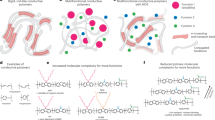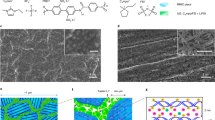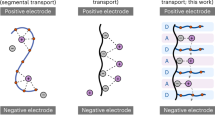Abstract
Energy storage is at present one of the foremost issues society faces. However, material challenges now serve as bottlenecks in technological progress1. Lithium-ion batteries are the current gold standard to meet energy storage needs; however, they are limited owing to the inherent instability of liquid electrolytes1,2. Block copolymers can self-assemble into nanostructures that simultaneously facilitate ion transport and provide mechanical stability. The ions themselves have a profound, yet previously unpredictable, effect on how these nanostructures assemble and thus the efficiency of ion transport3. Here we demonstrate that varying the charge of a block copolymer is a powerful mechanism to predictably tune nanostructures. In particular, we demonstrate that highly asymmetric charge cohesion effects can induce the formation of nanostructures that are inaccessible to conventional uncharged block copolymers, including percolated phases desired for ion transport. This vastly expands the design space for block copolymer materials and is informative for the versatile design of battery electrolyte materials.
This is a preview of subscription content, access via your institution
Access options
Subscribe to this journal
Receive 12 print issues and online access
$259.00 per year
only $21.58 per issue
Buy this article
- Purchase on Springer Link
- Instant access to full article PDF
Prices may be subject to local taxes which are calculated during checkout




Similar content being viewed by others
References
Armand, M. & Tarascon, J-M. Building better batteries. Nature 451, 652–657 (2008).
Hallinan, D. T. Jr. & Balsara, N. P. Polymer electrolytes. Annu. Rev. Mater. Res. 43, 503–525 (2013).
Wanakule, N. S., Virgili, J. M., Teran, A. A., Wang, Z-G. & Balsara, N. P. Thermodynamic properties of block copolymer electrolytes containing imidazolium and lithium salts. Macromolecules 43, 8282–8289 (2010).
Soo, P. P. et al. Rubbery block copolymer electrolytes for solid-state rechargeable lithium batteries. J. Electrochem. Soc. 146, 32–37 (1999).
Bouchet, R. et al. Single-ion BAB triblock copolymers as highly efficient electrolytes for lithium-metal batteries. Nature Mater. 12, 452–457 (2013).
Borodin, O. & Smith, G. D. Mechanism of ion transport in amorphous poly(ethylene oxide)/LTFSI from molecular dynamics simulations. Macromolecules 39, 1620–1629 (2006).
Sax, J. & Ottino, J. M. Modeling of transport of small molecules in polymer blends: Application of effective medium theory. Pol. Eng. Sci. 23, 165–176 (1983).
Elabd, Y. A., Napadensky, E., Walker, C. W. & Winey, K. I. Transport properties of sulfonated poly(styrene-b-isobutylene-b-styrene) triblock copolymers at high ion-exchange capacities. Macromolecules 39, 399–407 (2006).
Fredrickson, G. H. The Equilibrium Theory of Inhomogenous Polymers (Oxford Univ. Press, 2006).
Kim, S. O. et al. Epitaxial self-assembly of block copolymers on lithographically defined nano patterned substrates. Nature 424, 411–414 (2003).
Nie, Z. & Kumacheva, E. Patterning surfaces with functional polymers. Nature Mater. 7, 277–290 (2008).
Tavokkoli, A. et al. Templating three-dimensional self-assembled structures in bilayer block copolymer films. Science 336, 1294–1298 (2012).
Angelescu, D. E. et al. Macroscopic orientation of block copolymer cylinders in single-layer films by shearing. Adv. Mater. 16, 1736–1740 (2004).
Cui, H., Chen, Z., Zhong, S., Wooley, K. L. & Pochan, D. J. Block copolymer assembly via kinetic control. Science 317, 647–650 (2007).
Kim, S. H., Misner, M. J., Xu, T., Kimura, M. & Russell, T. P. Highly oriented and ordered arrays from block copolymers via solvent evaporation. Adv. Mater. 16, 226–231 (2004).
Kumar, R. & Muthukumar, M. Microphase separation in polyelectrolytic diblock copolymer melt: Weak segregation limit. J. Chem. Phys. 126, 214902 (2007).
Yang, S., Vishnyakov, A. & Neimark, A. V. Self-assembly in block polyelectrolytes. J. Chem. Phys. 134, 054104 (2011).
Marko, J. F. & Rabin, Y. Microphase separation of charged diblock copolymers: Melts and solutions. Macromolecules 25, 1503–1509 (1992).
Wang, Q., Taniguchi, T. & Fredrickson, G. H. Self-consistent field theory of polyelectrolyte systems. J. Phys. Chem. B 108, 6733–6744 (2004).
Wang, Z-G. Effects of ion solvation on the miscibility of binary polymer blends. J. Phys. Chem. B 112, 16205–16213 (2008).
Nakamura, I., Balsara, N. P. & Wang, Z-G. Thermodynamics of ion-containing polymer blends and block copolymers. Phys. Rev. Lett. 107, 198301 (2011).
Sing, C. E., Zwanikken, J. & Olvera de la Cruz, M. Interfacial behavior in polyelectrolyte blends: Hybrid liquid-state integral equation and self-consistent field theory study. Phys. Rev. Lett. 111, 168303 (2013).
Zwanikken, J. W., Jha, P. K. & Olvera de la Cruz, M. A practical integral equation for the structure and thermodynamics of hard sphere Coulomb fluids. J. Chem. Phys. 135, 064106 (2011).
Sing, C. E., Zwanikken, J. & Olvera de la Cruz, M. Ion correlation-induced phase separation in polyelectrolyte blends. ACS Macro Lett. 2, 1042–1046 (2013).
Huang, J., Tong, Z-Z., Zhou, B., Xu, J-T. & Fan, Z-Q. Salt-induced microphase separation in poly(ε-caprolactone)-b-poly(ethylene oxide) block copolymer. Polymer 54, 3098–3106 (2013).
Zhou, N. C., Burghardt, W. R. & Winey, K. I. Blend miscibility of suffocated polystyrene ionomers with polystyrene: Effect of counterion valency and neutralization level. Macromolecules 40, 6401–6405 (2007).
Park, M. J. & Balsara, N. P. Phase behavior of symmetric sulfonated block copolymers. Macromolecules 41, 3678–3687 (2008).
Park, M. J., Kim, S., Minor, A. M., Hexemer, A. & Balsara, N. P. Control of domain orientation in block copolymer electrolyte membranes at the interface with humid air. Adv. Mater. 21, 203–208 (2009).
Goswami, M. et al. Tunable morphologies from charged block copolymers. Soft Matter 6, 6146–6154 (2010).
Wang, X., Goswami, M., Kumar, R., Sumpter, B. G. & Mays, J. Morphologies of block copolymers composed of charged and neutral blocks. Soft Matter 8, 3036–3052 (2012).
Kang, Y., Walish, J. J., Gorishnyy, T. & Thomas, E. L. Broad-wavelength-range chemically tunable block-copolymer photonic gels. Nature Mater. 6, 957–960 (2007).
Bockstaller, M. R., Mickiewicz, R. A. & Thomas, E. L. Block copolymer nanocomposites: Perspectives for tailored functional materials. Adv. Mater. 17, 1331–1349 (2005).
Kataoka, K., Harada, A. & Nagasaki, Y. Block copolymer micelles for drug delivery: Design, characterization and biological significance. Adv. Drug Deliv. Rev. 47, 113–131 (2001).
Olson, D. A., Chen, L. & Hillmyer, M. A. Templating nanoporous polymers with ordered block copolymers. Chem. Mater. 20, 869–890 (2008).
Acknowledgements
The authors acknowledge support from NSF grant number DMR-1309027. C.E.S. thanks the Northwestern International Institute for Nanotechnology for an International Institute for Nanotechnology Postdoctoral Fellowship, J. McGinnis for helpful comments on the manuscript, and A. F. Hannon for help with three-dimensional block copolymer visualization. The computational cluster is funded by the Office of the Director of Defense Research and Engineering (DDR&E) and the Air Force Office of Scientific Research (AFOSR) under Award no. FA9551-10-1-0167.
Author information
Authors and Affiliations
Contributions
C.E.S., J.W.Z. and M.O.C. designed the research. C.E.S. and J.W.Z. developed the theoretical methods with input from M.O.C. C.E.S. performed the calculations. All authors contributed to the interpretation of the data and wrote the manuscript.
Corresponding author
Ethics declarations
Competing interests
The authors declare no competing financial interests.
Supplementary information
Supplementary Information
Supplementary Information (PDF 1853 kb)
Rights and permissions
About this article
Cite this article
Sing, C., Zwanikken, J. & Olvera de la Cruz, M. Electrostatic control of block copolymer morphology. Nature Mater 13, 694–698 (2014). https://doi.org/10.1038/nmat4001
Received:
Accepted:
Published:
Issue Date:
DOI: https://doi.org/10.1038/nmat4001
This article is cited by
-
Structural Properties of Ions and Polyelectrolytes in Aqueous Solutions under External Electric Fields: The Sign Effect
Chinese Journal of Polymer Science (2024)
-
Effect of cosolvent on the rheological properties and self-assembled structures from telechelic polyampholytes
Colloid and Polymer Science (2021)
-
High safety and long-life lithium batteries with low leakage and high wettability ceramic-polymer electrolyte
Ionics (2021)
-
Mg-ion conducting triblock copolymer electrolyte based on poly(VdCl-co-AN-co-MMA) with magnesium nitrate
Ionics (2020)
-
Superlattice by charged block copolymer self-assembly
Nature Communications (2019)



